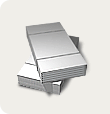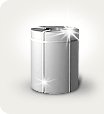Ultraviolet (UV) disinfection technology is a growing topic in the field of water treatment. With new applications, certifications and design concepts, UV technology is constantly evolving. For decades, UV disinfection has been done with a conventional mercury lamp, so most of the research and certifications have been around this type of lamp. UV Light Emitting Diodes (UV LEDs) are fundamentally different from mercury lamps and therefore open up new possibilities for disinfection. The benefits of UV LEDs include:
- Mercury-free. This allows disinfection in markets with material restrictions;
- Compact footprint This allows it to be integrated into existing products or systems;
- Instant on/off. This creates flexible work;
- Unlimited bikes. This allows it to be used intermittently;
- Temperature independent. This does not affect treated water;
- Wavelength selection. Systems can select a wavelength depending on the target pathogen; and
- Long change intervals. The lifetime of the LEDs only depends on when the systems are active.
Traditional UV technology has limited applications. Large footprint, limited number of cycles and on/off times require a narrow list of possible settings. With UV LEDs, this list is growing exponentially, opening up new design possibilities that push R&D to push the boundaries of technology. The following sections will look at the integration aspect of UV LED disinfection systems and how the location of this technology can add value to an integrated product or system.
UV LEDs are gaining popularity in water distribution and cooling systems, providing increased user safety. While UV LED technology has a number of advantages, exploiting these properties requires knowledge, experience and engineering know-how. Teams who have studied UV LED devices, developed UV LED systems, and understand UV disinfection offer more insights into advanced solutions for disinfection, water analysis and water treatment https://xn--80aaerkiz0a.com.ua/analiz.php. There are several installation concepts to consider when integrating UV LED systems.
Entrance disinfection
This method leaves disinfection outside of the device or process, leaving room for bacteria to grow anywhere in the system. The UV LED system is easier to replace, but with a lamp life of up to 10,000 hours, the need for replacement is less frequent than conventional mercury lamps. For example, 5,000 hours of operation at 2 l/min equals 600,000 liters of water supplied to customers. Inlet disinfection can also simplify installation as there is no need to redesign the system or modify the original product. However, installing a UV LED system at the inlet can make the system more cumbersome as the components are now exposed and more likely to be damaged or detached.
Disinfection in progress
The integration of a UV LED system brings additional benefits. In addition to protecting the UV component, the amount of possible contamination between the dosing point and the disinfection system is significantly reduced. This takes advantage of UV LED systems, which are compact and designed to instantly turn on/off automatically. One disadvantage is that this type of installation does not prevent retrograde contamination or the spread of bacteria through the pipeline from the point of use.
Point of consumption disinfection
Point-of-consumption applications provide the greatest protection against contamination in a product or system. By placing a UV LED system at the point of consumption, manufacturers benefit from last mile protection and protection from external contaminants. This type of UV disinfection system cannot exist without the compact size and instant on/off benefits of UV LEDs. While this design provides the greatest benefit to the product or system it is integrated into, it is also the most complex to design, and there are currently only a few applications that provide true point-of-consumption disinfection using UV LEDs. Retrograde contamination occurs when bacteria from external sources contaminate the system by growing through the pipeline into the system. Intermittent UV cycling ensures disinfection at the outlet, preventing growth.
Real applications
Although it is important to consider the possibilities of techno






